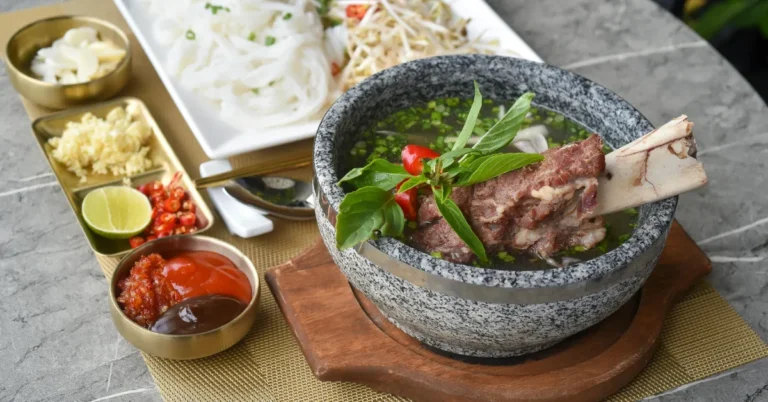Best Bone Broth Recipe For Gut Health
Bone broth has been called “liquid gold” for its healing properties—especially for your digestive system. Packed with collagen, amino acids like glutamine, and essential minerals, it supports the gut lining, reduces inflammation, and promotes better nutrient absorption.
If you’re dealing with bloating, leaky gut, or digestive discomfort, adding bone broth to your diet can be a game-changer. In this post, you’ll learn how to make the best bone broth recipe for gut health—the kind nutritionists recommend and chefs love for its flavor.

Why Bone Broth is Good for Your Gut
1. Collagen & Gelatin Support Gut Lining
The gelatin in bone broth helps repair and strengthen the intestinal wall, reducing permeability (a key issue in “leaky gut”).
2. Amino Acids for Reduced Inflammation
Glutamine, glycine, and proline help soothe and protect your digestive tract.
3. Rich in Minerals
Calcium, magnesium, phosphorus, and trace minerals support enzyme production and healthy digestion.
4. Easily Digestible Nutrition
Because it’s cooked slowly, the nutrients are broken down into a form your body can easily absorb — even if you have a sensitive gut.
What is bone broth?
Broth and stock are used interchangeably for basically the same thing: a savoury liquid made from bones with connective tissues and meat scraps and flavoured with vegetables. It might seem like I’m splitting hairs, but technically speaking bone broth and stocks are different.
What the blogosphere refers to as “broth” is technically a “stock” because it’s made from simmering bones, and sometimes tendons, skin and cartilage, for 6 to 24 hours.
Traditionally broths and stocks were used to make soups, stews, sauces and gravy but today, it’s the superfood du jour as a trendy drink.
The long-cooking process allows small amounts of nutrients in the bones (as well as the protein collagen) to leach into the water creating a flavorful liquid that is thicker than normal broth. Bones from beef and poultry are most common, and they are usually roasted before simmering if not from a previously cooked animal.
Why has bone broth become so popular?
In the past 10+ years, there’s been a revival of ancestral and traditional diets. First on the scene was likely paleo with an emphasis on grass-fed meats, pastured eggs, whole milk, and organ meats like liver, and offal. This is also referred to as nose-to-tail eating.
Soon to follow were stocks and broths and in the name of ancient traditions and pioneer cooking. Broths stocks have been a staple in the human diet for eons and their popularity stems from that culinary philosophy.
Is bone broth healthy?
Bone broth nutrition is promoted as a cure-all of sorts, but is it really? How well is this hot food trend really helping you to stay healthy? We know it uses part of the animal-like bones, meat, sometimes marrow. And broths use an acid, like vinegar, to help extract minerals from the bone during the cooking process but what’s the real deal?
A lot of people have written about bone broth and/or collagen and have concluded that neither are really helpful. They make statements like “consuming bone broth or collagen doesn’t improve bone health or skin health”. Or that “collagen isn’t a good quality protein [lacking essential amino acids] so it doesn’t benefit the body like whey”.
But that’s not the angle to take. Collagen, gelatin or bone broth provide the building blocks. Your body digests the protein, takes the amino acids, in this acid two in particular, and uses them to build new collagen in your body. This is how biology, nutrition and metabolism works.
Bone broth nutrition
In general, bone broth is very nutritious. But you may need to think beyond the traditional sense of the word.
The nutrient content of bone broth will vary to some degree depending on the type of bones used and whether or not connective tissue like ligaments etc are included.
Beef bones, like the ones in the image above, are good as they provide access to the bone marrow. Whole chicken or turkey carcasses don’t but that doesn’t mean their broth/stocks aren’t worth eating – they are.
Preparation method, the type of bones used, cooking times, and other ingredients etc will affect the exact nutrient content but bone broth will contain the following nutrients.
Vitamins and minerals
Despite what you read on the Internet, the amount of vitamins and minerals in bone broth is surprisingly low. The USDA found calcium in the range of 12 to 68 mg per 250 ml of broth as an example. Curiously, this has been known for awhile. King’s College Hospital did an analysis way back in 1934 and their results still stand today Bone and Vegetable Broth.
Not sure how this was lost over the years, where we got to the point of believing something just because it’s been repeated over and over (bone broth is rich in vitamins and minerals). Turns out most of the nutrients in broths and stocks come from the vegetables used to flavour it and not from the bones.
Collagen
Animal bones, your bones, they’re all rich in protein. Bones can be thought of as scaffolding made up of minerals with layers of protein throughout. Bones are rich in collagen, and therefore broth is too. Collagen can be digested by your body to yield two important amino acids (glycine and proline) which are used, in turn, to help rebuild the collagen in your own body.
Glycine and proline
Both abundant in the collagen found in the connective tissue, cartilage, tendons and the bones themselves, bone broth is a great source of easily digestible glycine and proline Although your body can make some of your own proline and glycine, evidence suggests you, me and everyone, can’t make enough of them for optimal health.
Gelatin
Also referred to as hydrolyzed collagen, gelatin is produce when collagen is cooked. Cooking, in this case simmering, breaks down the collagen to form gelatin. So both collagen and gelatin are good sources of protein, proline and glycine which you need to make your own good quality collagen.
Glutamine
Another important amino acid found in bone broth and is the most abundant amino acid in the blood. Under normal circumstances, you can make all the glutamine you need, but there are times when you need a little more.
Intestinal epithelial cells and activated immune cells eagerly consume glutamine for cellular energy. What’s more, glutamine has a special role in intestinal health. It helps to maintain your gut barrier function.
Glycoaminoglycans (GAGs)
GAGs – chondrotin, glucosamine, hyaluronic acid – are technically a type of carbobydrate that have both a structural and functional role in your body. They are used to maintain your connective tissue such as ligaments, tendons, and cartilage.
Gut health
One of bone broth’s claim to fame comes from the so-called “alternative” health world where it’s promoted as a way to heal a leaky gut. The term “leaky gut” tends to freak out most conventional health professional but it shouldn’t.
Leaky gut is real, and it goes the medical term “gut barrier dysfunction” where normal gut contents get into the bloodstream. Things like gut microorganisms, fungi, food proteins and toxins (lipopolysaccharide or LPS). When this happens, it can cause inflammation and a strong immune response = feeling like crap.
The nutrients in bone broth: collagen, gelatin, glycine and glutamine, have all been shown to sooth gut irritation and inflammation, strengthen the gut barrier and reduce the presence of LPS in the blood.
Bones and joint health
This question pours in all the time: is bone broth good for bone health? What about bone broth for osteoarthritis?
Studies support the main ingredient of bone broth, collagen, in reducing knee pain and overall joint health.
This trendy beverage also has support when it comes to helping those with osteoarthritis and the added collagen from the broth (diet) provides glycine (which is lacking in the modern diet), as well as, proline.
Best Bone Broth Recipe for Gut Health
Ingredients (for 4–5 liters of broth)
- 1.5–2 kg organic beef bones (marrow bones, knuckles, oxtail, or a mix)
- 2 medium carrots, chopped
- 2 stalks celery, chopped
- 1 large onion, quartered
- 4–5 cloves garlic, smashed
- 2 tbsp apple cider vinegar (helps extract minerals from bones)
- 2–3 bay leaves
- 1 tsp black peppercorns
- 1 tsp sea salt (add more later to taste)
- Fresh herbs (parsley, thyme, rosemary) — optional
- 4–5 liters filtered water
Instructions – Stove Top Method (12–24 hours)
- Roast the Bones (Optional) – For richer flavor, roast bones at 200°C (400°F) for 30 minutes.
- Combine Ingredients – Place bones, vegetables, vinegar, and seasonings in a large stockpot.
- Add Water – Cover with cold, filtered water, leaving a little space at the top.
- Bring to a Gentle Boil – Skim off any foam that rises to the surface in the first 30 minutes.
- Simmer Low & Slow – Reduce to a very low simmer and cook for 12–24 hours (longer = more nutrient extraction).
- Strain & Store – Remove bones and vegetables, strain into glass jars, and refrigerate or freeze.
Instant Pot Method (2–4 hours)
- Follow the same steps but pressure cook for 120–240 minutes, then natural release.
Slow Cooker Method (24–48 hours)
- Add all ingredients to a slow cooker, set on low, and cook for up to 48 hours.
Gut-Healing Tips for Maximum Benefits
- Use Joint Bones – Knuckles, chicken feet, and oxtails are richest in collagen.
- Add Fresh Herbs – Parsley and thyme have anti-inflammatory properties.
- Drink Warm on an Empty Stomach – Best absorbed first thing in the morning.
- Don’t Over-Salt – Add salt at the end to control flavor.
How to Store Bone Broth
- Fridge: Up to 5 days
- Freezer: Up to 6 months (freeze in ice cube trays for small portions)
How to Use Bone Broth Daily for Gut Health
- Sip it like tea in the morning
- Use as a base for soups, stews, or sauces
- Add to stir-fries instead of water
- Mix into mashed potatoes or quinoa for extra nutrition
Bone Broth Recipes That Will Support Your Gut Health
Enjoy the gut-healing benefits of these nine nutrient-packed bone broth recipes, designed to support digestion and promote overall wellness:
1. Beef Bone Broth
Rich in flavour and packed with nutrients, beef bone broth is your go-to for gut health, recovery, and a comforting boost anytime.
- Category: Beef
- Cuisine: American
- Servings: 4
- Prep Time: 15 minutes
- Cook Time: 12-24 hours
- Calories: ~150 per serving
Ingredients:
- 500g Beef Bones (Carnivore Society Beef Bones)
- 2 carrots, chopped
- 2 celery stalks, chopped
- 1 onion, quartered
- 3 garlic cloves, smashed
- 1 tbsp apple cider vinegar
- 12 cups of water
Preparation Steps:
- Place Carnivore Society Beef Bones in a large pot. Add carrots, celery, onion, garlic, and apple cider vinegar.
- Pour in enough water to cover the bones and bring to a boil.
- Reduce heat to low and simmer for 12-24 hours, adding water as needed.
- Strain the broth and discard the solids.
- Store in an airtight container and refrigerate or freeze for later use.
This hearty broth is full of collagen, ideal for promoting gut health and digestive repair.
2. Pork Bone Broth
Savory, collagen-rich, and deeply nourishing, pork bone broth delivers comfort in every sip and supports your joints, skin, and immune health.
- Category: Pork
- Cuisine: American
- Servings: 4
- Prep Time: 15 minutes
- Cook Time: 18 hours
- Calories: ~180 per serving
Ingredients:
- 500g Pork Bones (Carnivore Society Pork Bones)
- 2 onions, quartered
- 3 garlic cloves, smashed
- 2 carrots, chopped
- 2 celery stalks, chopped
- 1 tbsp apple cider vinegar
- 10 cups of water
Preparation Steps:
- Place Carnivore Society Pork Bones, onions, garlic, carrots, and celery in a large pot.
- Add water and bring to a boil, then reduce heat and simmer for 18 hours.
- Skim the broth occasionally, adding more water if necessary.
- Strain the broth and discard the solids.
- Store in containers and refrigerate or freeze.
This pork bone broth provides a rich, collagen-packed base to support gut health.
3. Lamb Bone Broth
Earthy, hearty, and full of depth, lamb bone broth offers a unique twist on traditional broths, packed with minerals and immune-boosting goodness.
- Category: Lamb
- Cuisine: Mediterranean
- Servings: 4
- Prep Time: 15 minutes
- Cook Time: 12 hours
- Calories: ~160 per serving
Ingredients:
- 500g Lamb Bones (Carnivore Society Lamb Bones)
- 1 onion, quartered
- 3 garlic cloves, smashed
- 2 carrots, chopped
- 2 celery stalks, chopped
- 1 tbsp rosemary
- 10 cups of water
Preparation Steps:
- Add Carnivore Society Lamb Bones, onion, garlic, carrots, celery, and rosemary to a large pot.
- Cover with water and bring to a boil.
- Reduce heat and simmer for 12 hours.
- Strain and discard the solids.
- Store in airtight containers and refrigerate or freeze.
A fragrant lamb bone broth that’s rich in collagen and great for promoting gut health.
4. Fish Bone Broth
Light, delicate, and brimming with omega-3s, salmon fish bone broth is a clean, mineral-rich elixir that supports brain, skin, and joint health.
- Category: Fish, Salmon
- Cuisine: Mediterranean
- Servings: 4
- Prep Time: 10 minutes
- Cook Time: 8-12 hours
- Calories: ~120 per serving
Ingredients:
- 500g Fish Bones
- 1 onion, quartered
- 2 carrots, chopped
- 2 celery stalks, chopped
- 1 tbsp dill
- 8-12 cups of water
Preparation Steps:
- Add Fish Bones, onion, carrots, celery, and dill to a large pot.
- Cover with water and bring to a boil.
- Simmer for 8-12 hours.
- Strain and discard solids.
- Store in the fridge or freeze for later.
A fish bone broth rich in omega-3 fatty acids that supports gut health and immunity.
5. Beef and Vegetable Bone Broth
Wholesome and hearty, beef and vegetable bone broth blends rich meaty depth with garden-fresh flavour, perfect for daily nourishment and digestive support.
- Category: Beef
- Cuisine: American
- Servings: 4
- Prep Time: 15 minutes
- Cook Time: 24 hours
- Calories: ~200 per serving
Ingredients:
- 500g Beef Bones
- 2 carrots, chopped
- 1 onion, quartered
- 2 celery stalks, chopped
- 3 garlic cloves, smashed
- 1 tbsp parsley
- 12 cups of water
Preparation Steps:
- Add Beef Bones, carrots, onion, celery, garlic, and parsley to a large pot.
- Cover with water and bring to a boil.
- Reduce heat and simmer for 24 hours.
- Strain and discard the solids.
- Store in airtight containers in the fridge or freeze.
A hearty, vegetable-infused beef broth for supporting gut repair and boosting immunity.







